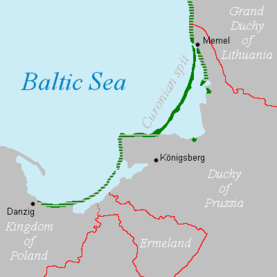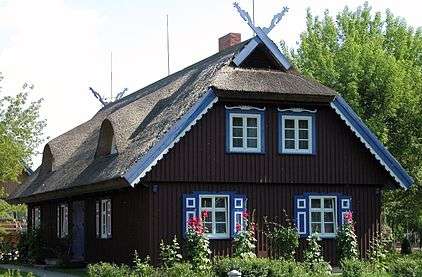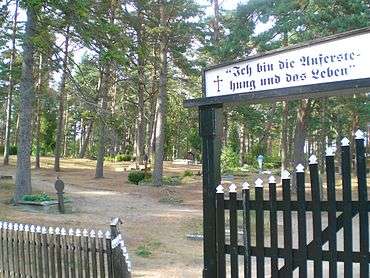Kursenieki
- For the extinct Baltic tribe, see Curonians.
| Total population | |
|---|---|
| (unknown) | |
| Regions with significant populations | |
| Lithuania, Germany, Poland | |
| Languages | |
| Latvian (Curonian) | |
| Religion | |
| Protestantism | |
| Related ethnic groups | |
| Latvians, Lietuvininks, Lithuanians |
The Kuršininkai (Curonians; German: Kuren; Lithuanian: kuršininkai; Latvian: kursenieki, kurši; Polish: kuronowie pruscy) are a nearly extinct Baltic ethnic group living along the Curonian Spit. "Kuršininkai" refers only to inhabitants of Lithuania and former East Prussia that speak a Latvian language dialect. Autochthonous inhabitants of Palanga in Lithuania call themselves "kuršininkai" as well,[1] but in Lithuania they usually are counted as Latvians.
Confusion
Kuršininkai/Kursenieki are often confused with the extinct Curonian Baltic tribe, as neighbouring ethnic groups called Kuršininkai/Kursenieki as Curonians: in German, Latvian and Lithuanian, Kuršininkai and the Curonian tribe are known by the same terms (Kuren, kurši and kuršiai respectively). In scientific Lithuanian literature, the name kuršininkai is used to distinguish them from the Curonian tribe. Similarly in Latvian kursenieki is used mostly exclusively by scientists to distinguish them from the Curonian tribe. On the other hand, Kuršininkai should not be confused with Kurzemnieki, which are the geographical group of Latvians from Courland. Kuršininkai are often considered descendants of the extinct Curonian tribe.
The Kuršininkai/Kursenieki have never designated themselves as Latvians and their own language was called "Curonian language" (kursenieku valoda). From a linguistic point of view, it is a dialect of Latvian. In German and Latvian writings of the 19th century, Kuršinikai sometimes are called "Prussian Latvians" (German: Preussische Letten; Latvian: Prūsijas latvieši). Kuršininkai were loyal to Germany and identified themselves as German citizens and ethnic Kuršininkas.
History

Origins
The origin of the Kuršininkai is unclear. One version says that they are indigenous descendants of the Curonian tribe who lived there since antiquity, at least along the Curonian Spit.[2] During the conquest of the Old Prussians and Curonians by the Teutonic Knights, the area became nearly uninhabited. In the process of various migrations of the 14th-17th centuries,[3][4][5] Curonians from Courland settled near Memel, along the Curonian Spit, and in Sambia (all regions in East Prussia). They preserved the old self-designation of Curonians (kurši), while Curonians who stayed in Courland became Latvians. The Kuršininkai were assimilated by Germans, except along the Curonian Spit where some still live. Until 1945, several places in Sambia were named after Kuršininkai, including Cranzkuhren, Neukuhren, Gross Kuhren (now Primorje), and Klein Kuhren (now Filino). In 1649 Kuršininkai lived from Memel (Klaipėda) to Danzig (Gdańsk). In the end of the 19th century the total number of Kuršininkai was around 4,000 persons.
Interbellum
Kuršininkai were considered Latvians after World War I when Latvia gained independence from the Russian Empire. This consideration was based on linguistic arguments and was the rationale for Latvian claims over the Curonian Spit, Memel, and some other territories of East Prussia. Later these claims were removed. In 1923 the newly created Memel Territory (Klaipėda Region) separated the Curonian Spit in two parts. This separation interrupted contacts between Kuršininkai. In 1933 Latvia tried to establish a cultural center for Kuršininkai of the Curonian Spit where the majority of them lived, but was opposed by Lithuania, to which the Memel Territory belonged. Latvian books that were sent to Kuršininkai were confiscated and accused of communist propaganda.
After World War II
Near the end of World War II, the majority of Kuršininkai fled from the Red Army during the evacuation of East Prussia. Kuršininkai that remained behind were subsequently expelled by the Soviet Union after the war and replaced with Russians and Lithuanians.
Some Kuršininkai managed to return to their homes after the war, but only 219 lived along the Curonian Spit in 1955. Many had German names such as Fritz or Hans, a cause for anti-German discrimination. Russian settlers called the Kuršininkai fascists, while Lithuanian settlers called them Prussians. In the Lithuanian SSR, church services in German were banned. Because of this discrimination, many immigrated to West Germany in 1958, where the majority of Kuršininkai now live. Neither Lithuania nor Russia has allowed the return to Kuršininkai of property confiscated after World War II.
Culture
Curonians are one of the Baltic tribes. Their Culture,religion and architecture is similar to those found in Germany and Sweden. Curonians are related with Lithuanians and Latvians. The Kuršininkai were predominantly Lutheran, like most former inhabitants of East Prussia, although some ancient pagan customs were preserved. Most Kuršininkai were bilingual or even trilingual: the Curonian language was used within the family and while fishing, German was used in everyday communication, and the language of church services was German and Lithuanian. The Kuršininkai were primarily fishermen. Some elements of cuisine are named after Kuršininkai, for example Curonian coffee (Kurenkaffee); a drink made of vodka flavoured with coffee, honey and other ingredients was popular throughout East Prussia. The first who took an interest in Kuršininkai culture and language was Paul Kwauka, a member of the separatist movement of Memel Territory. His book "Kurisches Wörterbuch" is a highly valuable source of information.The work of describing their heritage is continued by one of the last remaining Curonians, Richard Pietsch.[6]
-
Pennant of Curonian boat from Nida
-

Curonian house
-

Curonian cemetery in Nida
Language

The so-called New Curonian language (New Curonian: Kuršu valoda; German: Nehrungskurisch) is a dialect of the Latvian language spoken by the Kurši of the Curonian Spit, a thin strip of land stretching between southwestern Lithuania and Russia. In the process of various migrations of the 14th–17th centuries, Curonians (already speaking in Latvian) settled along the Curonian Spit in East Prussia and became known as the Kurši.
New Curonian was influenced by Old Prussian, Low German, High German and the Samogitian dialect successively, and by the end of the 18th century new Curonian dialects had formed, with the dialect of the Curonian Spit being notably distinct, due to its isolation from the mainland. New Curonian vocabulary published in 1927 shows: 60% of Curonian words were the same as Latvian, 26% were loanwords from “German” (i.e. Low German and High German), and 13% from Lithuanian dialects. The New Curonian language is mutually intelligible with Latvian, especially with its southwestern dialects, and Latvians can communicate easily with Kurši today.[7]
Before World War II, the New Curonian language was a sociolect of Kuršu fishermen of the Curonian Spit. In other spheres of everyday life Kurši used the Low German and High German languages. The events of the first half of the 20th century, including the Soviet and German occupations of the Baltic states and later East Prussia, led to the near extinction of the language, making it severely endangered. Several remaining native speakers live in Germany, having been expelled in the ethnic cleansing that took place in East Prussia after World War II.
Surnames
The surnames of Kuršininkai have various origins, including:
- Latvian, some with elements of Old Curonian: Gulbis, Kakies, Kuite, Kukulitis, Pinkis, Strangulis, Detzkeit, Jakeit
- Lithuanian: Kalvis, Lauzeningks
- Lithuanian or Latvian or Old Prussian: Dullis, Purwins
- German: Kiehr, Schmidt
- Protobaltic: Engelins
- Samogitian: Pietsch
- Polish: Schadowski
- Old Prussian: Schekahn
Famous people
- Immanuel Kant (1724–1804) had Kuršininkai roots on his paternal side.
- Ludwig Rhesa (1776–1840) translator, member of Lietuvininks movement.
See also
Notes
- ↑ "Lietuvis sauc mumis kuršininkās. Mes esam ne latviai, o kuršininkai" (Lithuanian) http://samogitia.mch.mii.lt/TAUTOSAKA/balcius.lt.htm, tr.: "Lithuanian calls us Curonians, we are not Latvians, we are Curonians".
- ↑ Preserved Baltic, Scandinavian toponyms shows that people in Curonian Spit lived from generation to generation without interruption to 1944.
- ↑ In the 15th century large scale emigration from Courland to Prussia has been documented. Bezzenberger A., Ueber die Sprache der Preussischen Letten, Goettingen, 1888.
- ↑ In 1541 documents mention 162 fishermen originating from Ventspils, Kandava and other places of Courland. Forstreuter K., 1981, Das Volk des Kurisches Nehrung,– Wirkungen des Preussenlandes, Köln
- ↑ 150 Curonians settled around Memel in 1630. 180 families arrived after 1655, some of them settled around Tilsit. A. Seraphim, Ueber Wanderungen lettischer Bauern aus Kurland nach Ostpreussen im 17. Jahrhundert, Altpreussische Monatsschrift, XXIX, 1892.
- ↑ Kavaliauskaitė, G. (2000). "Nežinomas Paulius Kvauka". Mokslas ir gyvenimas (in Lithuanian). 3.
- ↑ Pietsch, Richard: Deutsch-Kurisches Wörterbuch, Verlag Nordostdeutsches Kulturwerk Lüneburg 1991, p.17, ISBN 3-922296-60-2
External links
- Eva Pluhařova-Grigienė. The Curonian Spit: Identity and Cultural Heritage
- Historical features of the northern part of the curonian spit
- Map of languages in Prussia and Memelland in 1900 (German) large
- Die Kuren (German)
- Rietumbalti un viņu kaimiņi kultūru krustcelēs (Latvian)
- Kursenieki un to valoda Latvijas un latviešu pētījumos un publikācijās (Latvian)
- Paskutinioji kuršininkų karta (Lithuanian)
- Dalia Kiseliūnaitė. Kuršių Nerijos asmenvardžiai kaip gyventojų etninės sudėties liudininkai. Personennamen der Kurischen Nehrung als zeugen der der ethnischen Zusammensetzung der Bevölkerung (Lithuanian) (German)
- Baltu identitātes un etnosa saglabāšanās ilgtermiņa perspektīva. Baltų identiteto ir etnoso išlikimo ilgalaikė perspektyva. (Latvian) (Lithuanian)